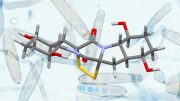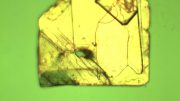
A team of chemists at the University of Basel have pioneered a new synthesis method for creating chiral, or “twisted,” helicenes—compounds critical to the advancement of organic light-emitting diodes (OLEDs)—which will open the door to better light sources.
Twisted molecules play an important role in the development of organic light-emitting diodes. A team of chemists has managed to create these compounds with exactly the three-dimensional structure that they wanted. In so doing, they are smoothing the path for new and better light sources.
They flash as a warning, glow red on standby mode, and light up your dinner table; light-emitting diodes (LEDs) have become indispensable in our daily lives. Somewhat less well-known, but just as ubiquitous, are organic light-emitting diodes, or OLEDs for short. This technology is used in the screens of smartphones, tablets, and monitors. It is cheaper to produce in the form of a thin-film component, but cannot yet compete with conventional LEDs in some ways, such as in light output and lifespan.
In the search for new molecules that possess the characteristics needed for OLEDs, compounds known as helicenes are playing a central role. Helicenes are a group of substances in which rings made up of six carbon atoms (benzene rings) are joined together in a helical structure. When synthesizing these compounds, it was previously difficult to control the direction in which the molecules twist – their “chirality.” It was only possible with certain types of helicenes and to a very limited extent.
A new concept in synthesis
Professor Olivier Baudoin, Dr. Shu-Min Guo, and Soohee Huh from the University of Basel’s Department of Chemistry have just made an important step forward. In the latest issue of Nature Chemistry, they describe a new concept in the synthesis of these important chiral molecules.
In their synthesis route, the Basel researchers make use of a reaction that can split a carbon-hydrogen and carbon-bromine bond and create a carbon-carbon bond. This is called C-H activation, and over the past few years, it has developed into a valuable tool in synthesis. This method allows chemists to create helicenes with the desired chirality, and could also be suitable for longer chains of benzene rings.
Researchers at Université Paris-Saclay in France have been able to demonstrate that the products synthesized by the team from Basel strongly absorb and emit circularly polarized light – an important characteristic for the development of new materials that rely on twisted molecules, as OLEDs do.
“Our results show the great potential of this strategy for the synthesis of such complex functional molecules,” says Olivier Baudoin. In their next step, he and his team intend to synthesize more complex helicenes with improved characteristics.
Reference: “A C–H activation-based enantioselective synthesis of lower carbo[n]helicenes” by Shu-Min Guo, Soohee Huh, Max Coehlo, Li Shen, Grégory Pieters and Olivier Baudoin, 6 April 2023, Nature Chemistry.
DOI: 10.1038/s41557-023-01174-5








May the theory of photonic flux serve as a constant to further the depths of your current scientific findings.